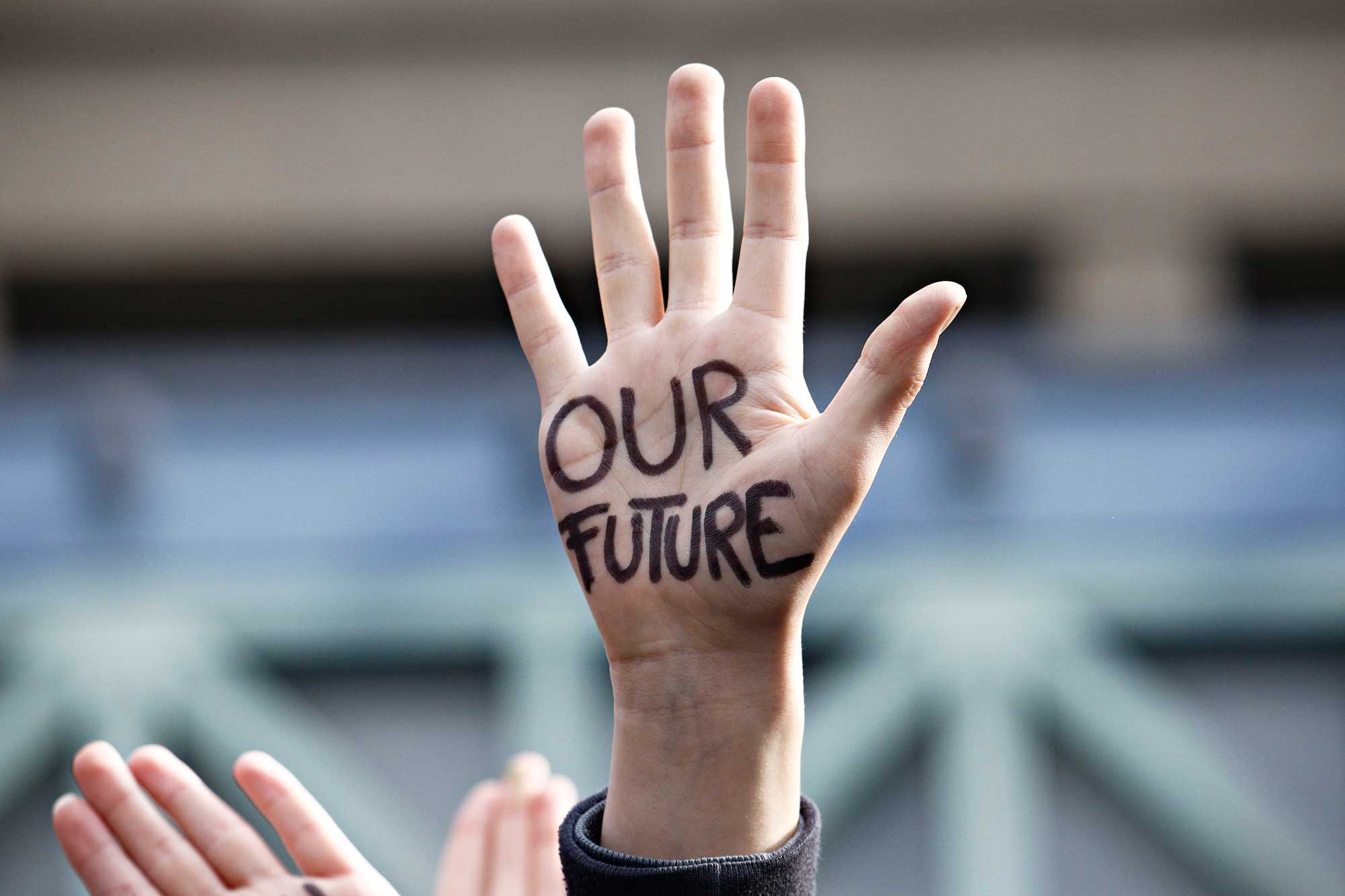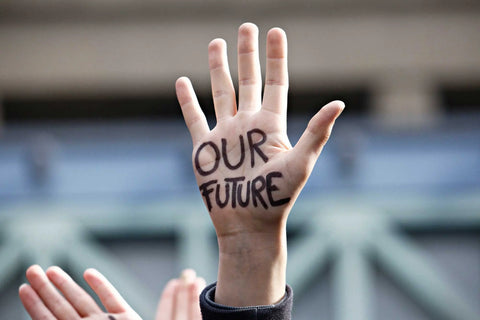
As the atmospheric temperatures rise, global leaders have charted a course of action to stabilize the climate. This agreement, known as the Paris Climate Agreement, has one main outlier in the international community: the United States. On June 1, 2017, President Trump announced his intention to withdraw from the agreement, casting doubt on the ability of the U.S. to uphold its commitments to take climate action.
In this blog post, we give an overview of the agreement including what it contains, what motivated Donald Trump’s decision, and how it has nevertheless inspired a strong show of support.

Here’s a brief primer on the contents of the agreement.
The Paris Agreement addresses a need to reduce heat-trapping greenhouse gas (GHG) emissions in order to keep the atmospheric temperature low enough to support food systems, a healthy economy and a sustainable future for people around the globe.
If you’re not familiar with the Paris Agreement, that may have been a lot to take in all at once. Its aims basically boil down to: setting a science-based target, upholding national sovereignty, balancing global inequality and ensuring accountability.
In December of 2015 at the UNFCCC’s COP21 held in Paris, France, the world adopted the Paris Agreement, the successor to the Kyoto Protocol. Compared to the Kyoto Protocol, the agreement is marked by consensus with all 197 member states signed on (for now).
From April 22, 2016 to April 21, 2017, the signing period for the Paris Agreement opened. According to the World Resources Institute, “Signing is important because it indicates a commitment by that country to refrain from acts that would defeat the object and purpose of the Agreement.”
Finally, member states should formally ratify the treaty for it to take full effect. However, the Paris Agreement establishes no deadline for signatories to do so. In total, 185 member states have ratified the Paris Agreement.
Currently, all member states of the United Nations have signed on to the Paris Agreement, totalling 197 signatories. Syria was the last to sign the Paris Agreement on November 7, 2017, which currently makes the U.S. the only country unwilling to join as a signatory following the announcement made by President Trump (see below).
For signatories to the Paris Agreement, the treaty is not legally binding. However, if a signatory ratifies the treaty, it officially agrees to hold itself responsible to meet its targets and incorporate it into national laws. As of 2018, just thirteen signatories had not ratified the Paris Agreement: Angola, Eritrea, Iran, Iraq, Kyrgyzstan, Lebanon, Libya, Oman, Russia, South Sudan, Suriname, Turkey and Yemen.
When Obama signed the Paris Agreement in 2016, the U.S. pledged to reduce GHGs by 26-28 percent by 2025 compared to 2005 levels and to pay $3 billion to financially support developing countries for the energy transition.
After President Donald Trump was elected, he announced a pledge in June 1, 2017, to withdraw from the Paris Agreement. His announcement stirred controversy, but may not have as large of an impact as he would like. In response, many states, cities and companies reaffirmed their commitment to reduce GHGs.
Due to formal procedures, the U.S. exit from the agreement won’t fully take effect until November 4, 2020, one day after the next presidential election.
President Trump claims that the Paris Agreement will hurt job growth, manufacturing and industries such as coal, natural gas, steel and cement. He expressed concern that American obligations were higher than those of China and India, and suggested that the U.S. would consider renegotiating the agreement.
These reasons don’t all add up, however. The countries that signed the Paris Agreement already consider it a renegotiated version of the Kyoto Protocol, and these renegotiations were largely led by the U.S. Difficulties with jobs and disadvantages for certain industries don’t depend on the contents of the Agreement, but on the way that the U.S. decides to meet its own targets. Lastly, Trump’s discomfort with its weighted responsibility for climate change denies the cumulative contributions the U.S. has made to climate change.
Before we get into the pros and cons of the Paris Agreement itself, it helps to recall how the Paris Agreement came about.
In some ways, international climate change action has always seemed too little, too late. But if we turn back the clock to the first benchmark of activity, it came quite early on. In 1979, scientists held the first World Climate Conference, exploring the potential impacts of climate change on people.
Eventually, the international community made its own formal recognition of climate change by forming the International Panel on Climate Change in 1988. The IPCC released its first report in 1990, calling upon leaders to form a global treaty on climate change.
This led to the establishment of the United Nations Framework Convention on Climate Change (UNFCCC) in 1994. All 197 member states of the UN signed the UNFCCC and its first Conference of Parties (COP1) was held in Berlin, Germany, in 1992.
As a result of this forward-thinking activity, the world adopted its first climate treaty, the Kyoto Protocol, in 1997 at COP3 in Kyoto, Japan. The treaty foremost challenges the world’s 37 developed countries to reduce GHG emissions. For developing countries, including coal-dependent China and India, participation remains optional.
The Protocol didn’t fully enter into force until 2005 when Canada and Russia signed on. The U.S. had already withdrawn from it in 2001 and Canada later withdrew in 2011. The Kyoto Protocol is still currently active until 2020, with targets for parties (192 in total) to reduce carbon emissions from 1990 levels by 18 percent.
Meanwhile, the Paris Agreement has taken the baton, replacing the Kyoto Protocol. It sets a new net-zero international target for 2050, according to negotiations that had aimed at correcting some of the Kyoto Protocol’s flaws.
Trump’s Paris Climate Agreement announcement feels a little bit like déjà vu. The first time the U.S. declined to sign an international treaty on climate happened when President George W. Bush announced his intention to withdraw from the Kyoto Protocol in 2001.
George Bush’s reasons to withdraw, some of which are similar to Trump’s reasons, related foremost to the U.S. economy. He argued that not enough environmental good would come from the Protocol in comparison with the economic drain it would place on the U.S. economy.
Moreover, the strategy of targeting the world’s worst polluters (developed countries only), rather than all polluters (developing countries included), put too much pressure on the U.S. He also felt incentives rather than punishments should be used to inspire climate action.
Finally, his arguments also relied upon skepticism about the science and the lack of clear solutions, sentiments which have since been debunked by the full consensus of the scientific community that climate change is happening and it is a manmade problem.
While it has some perceived imperfections, the underlying purpose of the Paris Agreement--to prevent climate change catastrophe--remains a noble cause. Here are some of its pluses and minuses.
Setting aside the perspective of the U.S. for the moment, I would first like to address the pitfalls of the Paris Agreement for achieving its stated aims:
In short, the Paris Agreement might look like a bad deal to some, but it represents significant progress on getting the world to agree to take climate action.
While all of the premises of the Paris Climate Agreement are beneficial, there are some less obvious benefits that should also be noted.
It comes with added health benefits, since efforts to reduce GHGs can also improve air quality. Air pollution currently kills 7 million people every year.
Many countries that had achieved consensus on the Paris Agreement felt frustrated by Trump’s announcement. Yet, the growing level of awareness of and concern about climate change has triggered leaders to reaffirm their commitments. States, cities and corporations throughout the United States have expressed their continued support for the agreement.
Following Trump’s announcement to withdraw from the Paris Agreement, a groundswell of support for the agreement erupted. As a result, a number of organizations formed to recognize formal climate change commitments in line with the Paris Agreement by local entities, organizations and businesses in the U.S. Here are a few of them.
We are Still In is an ad-hoc agreement with 3,500 signatories expressing support for the Paris Agreement, and according to its website, these signatories, “represent a constituency of more than half of all Americans, and taken together, they represent $6.2 trillion, a bigger economy than any nation other than the U.S. or China.”
America’s Pledge is designed to serve as a stand in for the federal government to help the states and organizations with their own climate commitments to coordinate and aggregate the impacts of their actions. This gives America a way to show the impact achieved by the nation as a whole.
The United States Climate Alliance helps coordinate state-level activities aimed at achieving the goals set out by the Paris Agreement commitments the United States made when it initially became a signatory.
In May, the Democrat-led House of Representatives passed its first noteworthy climate change legislation in about a decade with a 231-190 majority of votes. It aims at preventing the U.S. from withdrawing from the Paris Agreement. After it goes on to the Republican-led Senate, it could easily get voted down, however.
Whether or not the U.S. remains a signatory to the Paris Agreement, it is clear that leaders throughout America still feel the need to make climate action and commit to reduce GHGs for a sustainable future.
Don’t you love to sip on a tasty beverage while reading articles on the internet?
Sip comfortably with our long-lasting Cruisers that come with their own metal straw (and straw cleaning brush!).
Compared to paper coffee cups, they’re a lot more gentle on the fingertips (no more burns) and the landfill (no more waste).
https://unfccc.int/process-and-meetings/the-paris-agreement/the-paris-agreement
https://www.ipcc.ch/sr15/
https://www.youtube.com/watch?v=jx85qK1ztAc
https://www.wri.org/faqs-about-how-paris-agreement-enters-force
https://unfccc.int/process/the-paris-agreement/status-of-ratification
https://www.climatechangenews.com/2018/07/12/countries-yet-ratify-paris-agreement/
https://www.britannica.com/story/us-exits-paris-climate-agreement
https://unfccc.int/process/the-convention/history-of-the-convention#eq-2
https://unfccc.int/process-and-meetings/the-convention/what-is-the-united-nations-framework-convention-on-climate-change
https://unfccc.int/kyoto_protocol
https://abcnews.go.com/Politics/time-us-president-dumped-global-climate-deal/story?id=47771005
https://www.npr.org/templates/story/story.php?storyId=5042766
https://www.theguardian.com/science/2019/jul/24/scientific-consensus-on-humans-causing-global-warming-passes-99
https://climateactiontracker.org/global/temperatures/
https://www.forbes.com/sites/dominicdudley/2019/05/29/renewable-energy-costs-tumble/#333c8095e8ce
https://www.npr.org/2017/05/18/528998592/energy-companies-urge-trump-to-remain-in-paris-climate-agreement
https://www.un.org/sustainabledevelopment/sustainable-development-goals/
https://www.cbd.int/
https://www.who.int/air-pollution/news-and-events/how-air-pollution-is-destroying-our-health
https://www.wearestillin.com/
https://www.americaspledgeonclimate.com/
https://www.usclimatealliance.org/
https://www.apnews.com/0dba30a472b54e32bc91211d82114125